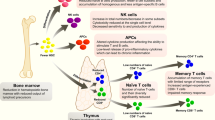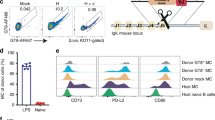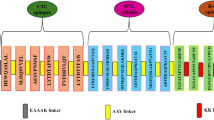Abstract
Vaccination, or the deliberate induction of protective immunity by administering nonpathogenic forms of a microbe or its antigens to induce a memory immune response, is the world's most cost-effective medical procedure for preventing morbidity and mortality caused by infectious disease1. Historically, most vaccines have worked by eliciting long-lived plasma cells. These cells produce antibodies that limit disease by neutralizing a toxin or blocking the spread of the infectious agent. For these 'B cell vaccines,' the immunological marker, or correlate, for protection is the titer of protective antibodies. With the discovery of HIV/AIDS, vaccine development has been confronted by an agent that is not easily blocked by antibody2. To overcome this, researchers who are developing HIV/AIDS vaccines have turned to the elicitation of cellular immunity, or 'T cell vaccines,' which recognize and kill infected cells3,4.
This is a preview of subscription content, access via your institution
Access options
Subscribe to this journal
Receive 12 print issues and online access
$259.00 per year
only $21.58 per issue
Buy this article
- Purchase on SpringerLink
- Instant access to full article PDF
Prices may be subject to local taxes which are calculated during checkout




Similar content being viewed by others
References
Nossal, G.J. The Global Alliance for Vaccines and Immunization—a millennial challenge. Nat. Immunol. 1, 5–8 (2000).
Burton, D.R. et al. HIV vaccine design and the neutralizing antibody problem. Nat. Immunol. 5, 233–236 (2004).
Robinson, H.L. New Hope for an AIDS Vaccine. Nat. Rev. Immunol. 2, 239–250 (2002).
Letvin, N.L. Progress toward an HIV vaccine. Annu. Rev. Med. 56, 213–223 (2005).
Bourgeois, C., Rocha, B. & Tanchot, C. A role for CD40 expression on CD8+ T cells in the generation of CD8+ T cell memory. Science 297, 2060–2063 (2002).
Janssen, E.M. et al. CD4+ T cells are required for secondary expansion and memory in CD8+ T lymphocytes. Nature 421, 852–856 (2003).
Shedlock, D.J. & Shen, H. Requirement for CD4 T cell help in generating functional CD8 T cell memory. Science 300, 337–339 (2003).
Sun, J.C. & Bevan, M.J. Defective CD8 T cell memory following acute infection without CD4 T cell help. Science 300, 339–342 (2003).
Sun, J.C., Williams, M.A. & Bevan, M.J. CD4+ T cells are required for the maintenance, not programming, of memory CD8+ T cells after acute infection. Nat. Immunol. 5, 927–933 (2004).
Borrow, P. et al. CD40L-deficient mice show deficits in antiviral immunity and have an impaired memory CD8+ CTL response. J. Exp. Med. 183, 2129–2142 (1996).
Rubbert, A. et al. Multifactorial nature of noncytolytic CD8+ T cell-mediated suppression of HIV replication: beta-chemokine-dependent and -independent effects. AIDS Res. Hum. Retroviruses 13, 63–69 (1997).
Levy, J.A., Mackewicz, C.E. & Barker, E. Controlling HIV pathogenesis: the role of the noncytotoxic anti-HIV response of CD8+ T cells. Immunol. Today 17, 217–224 (1996).
Pal, R. et al. Inhibition of HIV-1 infection by the beta-chemokine MDC. Science 278, 695–698 (1997).
Amara, R.R. et al. Critical role for Env as well as Gag-Pol in control of a simian-human immunodeficiency virus 89.6P challenge by a DNA prime/recombinant modified vaccinia virus Ankara vaccine. J. Virol. 76, 6138–6146 (2002).
Amara, R.R. et al. Different patterns of immune responses but similar control of a mucosal immunodeficiency virus challenge by MVA and DNA/MVA vaccines. J. Virol. 76, 7625–7631 (2002).
Smith, J.M. et al. Multiprotein HIV-1 Clade B DNA/MVA Vaccine: Construction, Safety and Immunogenicity. AIDS Res. Hum. Retroviruses 20, 654–665 (2004).
Smith, J.M. et al. DNA/MVA vaccine for HIV type 1: effects of codon-optimization and the expression of aggregates or virus-like particles on the immunogenicity of the DNA prime. AIDS Res. Hum. Retroviruses 20, 1335–1347 (2004).
Sette, A. & Fikes, J. Epitope-based vaccines: an update on epitope identification, vaccine design and delivery. Curr. Opin. Immunol. 15, 461–470 (2003).
Goulder, P.J. & Watkins, D.I. HIV and SIV CTL escape: implications for vaccine design. Nat. Rev. Immunol. 4, 630–640 (2004).
Lechner, F. et al. Analysis of successful immune responses in persons infected with hepatitis C virus. J. Exp. Med. 191, 1499–1512 (2000).
Wherry, E.J., Blattman, J.N., Murali-Krishna, K., van der Most, R. & Ahmed, R. Viral persistence alters CD8 T-cell immunodominance and tissue distribution and results in distinct stages of functional impairment. J. Virol. 77, 4911–4927 (2003).
Kostense, S. et al. Persistent numbers of tetramer+ CD8(+) T cells, but loss of interferon-gamma+ HIV-specific T cells during progression to AIDS. Blood 99, 2505–2511 (2002).
Sadagopal, S. et al. Signature for Long-term vaccine-mediated controlof as SHIV-98.6P challenge: Stable low breadth and low frequency T cell response capable of co-producing IFN-gamma and IL-2. J. Virol. 79, 3243–3253 (2005).
McKay, P.F. et al. Vaccine protection against functional CTL abnormalities in simian human immunodeficiency virus-infected rhesus monkeys. J. Immunol. 168, 332–337 (2002).
Migueles, S.A. et al. HIV-specific CD8+ T cell proliferation is coupled to perforin expression and is maintained in nonprogressors. Nat. Immunol. 3, 1061–1068 (2002).
Kaech, S.M., Wherry, E.J. & Ahmed, R. Effector and memory T-cell differentiation: implications for vaccine development. Nat. Rev. Immunol. 2, 251–262 (2002).
Welsh, R.M., Selin, L.K. & Szomolanyi-Tsuda, E. Immunological memory to viral infections. Annu. Rev. Immunol. 22, 711–743 (2004).
Ahmed, R. & Gray, D. Immunological memory and protective immunity: understanding their relation. Science 272, 54–60 (1996).
Banchereau, J. & Steinman, R.M. Dendritic cells and the control of immunity. Nature 392, 245–252 (1998).
Grayson, J.M., Harrington, L.E., Lanier, J.G., Wherry, E.J. & Ahmed, R. Differential sensitivity of naive and memory CD8+ T cells to apoptosis in vivo. J. Immunol. 169, 3760–3770 (2002).
Badovinac, V.P., Messingham, K.A., Hamilton, S.E. & Harty, J.T. Regulation of CD8+ T cells undergoing primary and secondary responses to infection in the same host. J. Immunol. 170, 4933–4942 (2003).
Amara, R.R., Nigam, P., Sharma, S., Liu, J. & Bostik, V. Long-lived poxvirus immunity, robust CD4 help, and better persistence of CD4 than CD8 T cells. J. Virol. 78, 3811–3816 (2004).
Hammarlund, E. et al. Duration of antiviral immunity after smallpox vaccination. Nat. Med. 9, 1131–1137 (2003).
Crotty, S. et al. Cutting edge: long-term B cell memory in humans after smallpox vaccination. J. Immunol. 171, 4969–4973 (2003).
Demkowicz, W.E., Jr., Littaua, R.A., Wang, J. & Ennis, F.A. Human cytotoxic T-cell memory: long-lived responses to vaccinia virus. J. Virol. 70, 2627–2631 (1996).
Wherry, E.J., Puorro, K.A., Porgador, A. & Eisenlohr, L.C. The induction of virus-specific CTL as a function of increasing epitope expression: responses rise steadily until excessively high levels of epitope are attained. J. Immunol. 163, 3735–3745 (1999).
Pardigon, N. et al. Role of co-stimulation in CD8+ T cell activation. Int. Immunol. 10, 619–630 (1998).
Whitmire, J.K. & Ahmed, R. Costimulation in antiviral immunity: differential requirements for CD4(+) and CD8(+) T cell responses. Curr. Opin. Immunol. 12, 448–455 (2000).
Marrack, P. & Kappler, J. Control of T cell viability. Annu. Rev. Immunol. 22, 765–787 (2004).
Blattman, J.N. et al. Therapeutic use of IL-2 to enhance antiviral T-cell responses in vivo. Nat. Med. 9, 540–547 (2003).
Yajima, T. et al. Overexpression of IL-15 in vivo increases antigen-driven memory CD8+ T cells following a microbe exposure. J. Immunol. 168, 1198–1203 (2002).
Khan, I.A. & Casciotti, L. IL-15 prolongs the duration of CD8+ T cell-mediated immunity in mice infected with a vaccine strain of Toxoplasma gondii. J. Immunol. 163, 4503–4509 (1999).
Sprent, J., Zhang, X., Sun, S. & Tough, D. T-cell proliferation in vivo and the role of cytokines. Philos. Trans. R. Soc. Lond. B Biol. Sci. 355, 317–322 (2000).
Badovinac, V.P., Tvinnereim, A.R. & Harty, J.T. Regulation of antigen-specific CD8+ T cell homeostasis by perforin and interferon-gamma. Science 290, 1354–1358 (2000).
Kagi, D., Odermatt, B. & Mak, T.W. Homeostatic regulation of CD8+ T cells by perforin. Eur. J. Immunol. 29, 3262–3272 (1999).
Matloubian, M. et al. A role for perforin in downregulating T-cell responses during chronic viral infection. J Virol 73, 2527–36 (1999).
Sallusto, F., Lenig, D., Forster, R., Lipp, M. & Lanzavecchia, A. Two subsets of memory T lymphocytes with distinct homing potentials and effector functions. Nature 401, 708–712 (1999).
Sallusto, F., Geginat, J. & Lanzavecchia, A. Central memory and effector memory T cell subsets: function, generation, and maintenance. Annu. Rev. Immunol. 22, 745–763 (2004).
Appay, V. et al. Memory CD8+ T cells vary in differentiation phenotype in different persistent virus infections. Nat. Med. 8, 379–385 (2002).
Ravkov, E.V., Myrick, C.M. & Altman, J.D. Immediate early effector functions of virus-specific CD8+CCR7+ memory cells in humans defined by HLA and CC chemokine ligand 19 tetramers. J. Immunol. 170, 2461–2468 (2003).
Geginat, J., Lanzavecchia, A. & Sallusto, F. Proliferation and differentiation potential of human CD8+ memory T-cell subsets in response to antigen or homeostatic cytokines. Blood 101, 4260–4266 (2003).
Faint, J.M. et al. Memory T cells constitute a subset of the human CD8+CD45RA+ pool with distinct phenotypic and migratory characteristics. J. Immunol. 167, 212–220 (2001).
van Leeuwen, E.M. et al. Proliferation requirements of cytomegalovirus-specific, effector-type human CD8+ T cells. J. Immunol. 169, 5838–5843 (2002).
Champagne, P. et al. Skewed maturation of memory HIV-specific CD8 T lymphocytes. Nature 410, 106–111 (2001).
Wherry, E.J. et al. Lineage relationship and protective immunity of memory CD8 T cell subsets. Nat. Immunol. 4, 225–234 (2003).
Prlic, M., Lefrancois, L. & Jameson, S.C. Multiple choices: regulation of memory CD8 T cell generation and homeostasis by interleukin (IL)-7 and IL-15. J. Exp. Med. 195, F49–F52 (2002).
Tan, J.T. et al. Interleukin (IL)-15 and IL-7 jointly regulate homeostatic proliferation of memory phenotype CD8+ cells but are not required for memory phenotype CD4+ cells. J. Exp. Med. 195, 1523–1532 (2002).
Pulendran, B. Modulating vaccine responses with dendritic cells and Toll-like receptors. Immunol. Rev. 199, 227–250 (2004).
Schneider, J. et al. Induction of CD8+ T cells using heterologous prime-boost immunisation strategies. Immunol. Rev. 170, 29–38 (1999).
Robinson, H.L., Smith, J.M. & Amara, R.R. AIDS Vaccines: Heterologous Prime/Boost Strategies for raising Protective T Cell Responses. AIDS Rev. 2, 105–110 (2000).
Sumida, S.M. et al. Neutralizing antibodies and CD8+ T lymphocytes both contribute to immunity to adenovirus serotype 5 vaccine vectors. J. Virol. 78, 2666–2673 (2004).
Shiver, J.W. & Emini, E.A. Recent advances in the development of HIV-1 vaccines using replication-incompetent adenovirus vectors. Annu. Rev. Med. 55, 355–372 (2004).
Reyes-Sandoval, A. et al. Human immunodeficiency virus type 1-specific immune responses in primates upon sequential immunization with adenoviral vaccine carriers of human and simian serotypes. J. Virol. 78, 7392–7399 (2004).
Yang, Z.Y. et al. Overcoming immunity to a viral vaccine by DNA priming before vector boosting. J. Virol. 77, 799–803 (2003).
Allen, T.M. et al. Induction of AIDS virus-specific CTL activity in fresh, unstimulated peripheral blood lymphocytes from rhesus macaques vaccinated with a DNA Prime/Modified vaccinia virus ankara boost regimen. J. Immunol. 164, 4968–4978 (2000).
Reimann, K.A. et al. A chimeric simian/human immunodeficiency virus expressing a primary patient human immunodeficiency virus type 1 isolate env causes an AIDS-like disease after in vivo passage in rhesus monkeys. J. Virol. 70, 6922–6928 (1996).
Barouch, D.H. et al. Augmentation and suppression of immune responses to an HIV-1 DNA vaccine by plasmid cytokine/Ig administration. J. Immunol. 161, 1875–1882 (1998).
Santra, S. et al. Recombinant poxvirus boosting of DNA-primed rhesus monkeys augments peak but not memory T lymphocyte responses. Proc. Natl. Acad. Sci. USA 101, 11088–11093 (2004).
Appay, V. et al. HIV-specific CD8(+) T cells produce antiviral cytokines but are impaired in cytolytic function. J. Exp. Med. 192, 63–75 (2000).
Gruener, N.H. et al. Sustained dysfunction of antiviral CD8+ T lymphocytes after infection with hepatitis C virus. J. Virol. 75, 5550–5558 (2001).
Barouch, D.H. et al. Eventual AIDS vaccine failure in a rhesus monkey by viral escape from cytotoxic T lymphocytes. Nature 415, 335–339 (2002).
Kahn, P. AIDS Vaccines, From Monkeys to People: An Interview with John Shriver. in IAVI Report Vol. 7 10–12 (International AIDS Vaccine Initiative, New York, 2003).
Altman, J.D. et al. Phenotypic analysis of antigen-specific T lymphocytes. Science 274, 94–96 (1996).
Waldrop, S.L., Pitcher, C.J., Peterson, D.M., Maino, V.C. & Picker, L.J. Determination of antigen-specific memory/effector CD4+ T cell frequencies by flow cytometry: evidence for a novel, antigen-specific homeostatic mechanism in HIV-associated immunodeficiency. J. Clin. Invest. 99, 1739–1750 (1997).
Waldrop, S.L., Davis, K.A., Maino, V.C. & Picker, L.J. Normal human CD4+ memory T cells display broad heterogeneity in their activation threshold for cytokine synthesis. J. Immunol. 161, 5284–5295 (1998).
Lyons, A.B. & Parish, C.R. Determination of lymphocyte division by flow cytometry. J. Immunol. Methods 171, 131–137 (1994).
De Rosa, S.C. et al. Vaccination in humans generates broad T cell cytokine responses. J. Immunol. 173, 5372–5380 (2004).
MacGregor, R.R. et al. First human trial of a facilitated DNA plasmid vaccine for HIV-1: safety and host response. in Int. Conf. AIDS 11, 23 (abstract no. We.B.293) (1996).
MacGregor, R.R. et al. First human trial of a DNA-based vaccine for treatment of human immunodeficiency virus type 1 infection: safety and host response. J. Infect. Dis. 178, 92–100 (1998).
Moorthy, V.S. et al. Safety of DNA and modified vaccinia virus Ankara vaccines against liver-stage P. falciparum malaria in non-immune volunteers. Vaccine 21, 1995–2002 (2003).
Moorthy, V.S. et al. Safety and immunogenicity of DNA/modified vaccinia virus ankara malaria vaccination in African adults. J. Infect. Dis. 188, 1239–1244 (2003).
McConkey, S.J. et al. Enhanced T-cell immunogenicity of plasmid DNA vaccines boosted by recombinant modified vaccine virus Ankara in humans. Nat. Med. 9, 729–735 (2003).
Moorthy, V.S. et al. Phase 1 evaluation of 3 highly immunogenic prime-boost regimens, including a 12-month reboosting vaccination, for malaria vaccination in Gambian men. J. Infect. Dis. 189, 2213–2219 (2004).
Moore, A.C. & Hill, A.V. Progress in DNA-based heterologous prime-boost immunization strategies for malaria. Immunol. Rev. 199, 126–143 (2004).
McShane, H. et al. Recombinant modified vaccinia virus Ankara expressing antigen 85A boosts BCG-primed and naturally acquired antimycobacterial immunity in humans. Nat. Med. 10, 1240–1244 (2004).
Lai, C.J. & Monath, T.P. Chimeric flaviviruses: novel vaccines against dengue fever, tick-borne encephalitis, and Japanese encephalitis. Adv. Virus Res. 61, 469–509 (2003).
Kaech, S.M. & Ahmed, R. Memory CD8+ T cell differentiation: initial antigen encounter triggers a developmental program in naive cells. Nat. Immunol. 2, 415–422 (2001).
Wyand, M.S., Manson, K.H., Garcia-Moll, M., Montefiori, D. & Desrosiers, R.C. Vaccine protection by a triple deletion mutant of simian immunodeficiency virus. J. Virol. 70, 3724–3733 (1996).
Amara, R.R. et al. Control of a Mucosal Challenge and Prevention of AIDS by a Multiprotein DNA/MVA Vaccine. Science 292, 69–74 (2001).
Shiver, J.W. et al. Replication-incompetent adenoviral vaccine vector elicits effective anti-immunodeficiency virus immunity. Nature 415, 331–335 (2002).
Barouch, D.H. et al. Augmentation of immune responses to HIV-1 and simian immunodeficiency virus DNA vaccines by IL-2/Ig plasmid administration in rhesus monkeys. Proc. Natl. Acad. Sci. USA 97, 4192–4197 (2000).
Barouch, D.H. et al. Control of viremia and prevention of clinical AIDS in rhesus monkeys by cytokine-augmented DNA vaccination. Science 290, 486–492 (2000).
Acknowledgements
We are indebted to R. Ahmed, J. Altman, F. Villinger, V. Pillai, L. Lai and J. Zhao for critical review of the manuscript and to H. Drake-Perrow for administrative assistance. This work was supported by National Public Health Service Integrated Preclinical/Clinical AIDS Vaccine Development Grants P01-AI 43045 and P01-AI49364, the Emory/Atlanta Center for AIDS Research, P30 DA 12121, and the Yerkes National Primate Research Center base grant, P51 RR000165.
Author information
Authors and Affiliations
Corresponding author
Ethics declarations
Competing interests
Drs. Robinson and Amara have pending patents for HIV vaccines modeled on the DNA/MVA SHIV vaccine reported in this review. Dr. Robinson also holds a minor equity interest in GeoVax Inc., the company that has licensed the technology for a DNA/MVA HIV/AIDS vaccine.
Rights and permissions
About this article
Cite this article
Robinson, H., Amara, R. T cell vaccines for microbial infections. Nat Med 11 (Suppl 4), S25–S32 (2005). https://doi.org/10.1038/nm1212
Published:
Issue date:
DOI: https://doi.org/10.1038/nm1212
This article is cited by
-
Are CD45RO+ and CD45RA- genuine markers for bovine memory T cells?
Animal Diseases (2022)
-
Salmonella enterica serovar Typhi exposure elicits ex vivo cell-type-specific epigenetic changes in human gut cells
Scientific Reports (2020)
-
A conserved multi-epitope-based vaccine designed by targeting hemagglutinin protein of highly pathogenic avian H5 influenza viruses
3 Biotech (2020)
-
Immune-adjuvant loaded Bi2Se3 nanocage for photothermal-improved PD-L1 checkpoint blockade immune-tumor metastasis therapy
Nano Research (2019)
-
Increased frequency of systemic pro-inflammatory Vδ1+ γδ T cells in HIV elite controllers correlates with gut viral load
Scientific Reports (2018)



